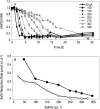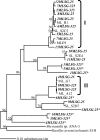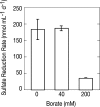Effects of imposed salinity gradients on dissimilatory arsenate reduction, sulfate reduction, and other microbial processes in sediments from two California soda lakes
- PMID: 17601810
- PMCID: PMC1950999
- DOI: 10.1128/AEM.00771-07
Effects of imposed salinity gradients on dissimilatory arsenate reduction, sulfate reduction, and other microbial processes in sediments from two California soda lakes
Erratum in
- Appl Environ Microbiol. 2008 Jun;74(11):3618
Abstract
Salinity effects on microbial community structure and on potential rates of arsenate reduction, arsenite oxidation, sulfate reduction, denitrification, and methanogenesis were examined in sediment slurries from two California soda lakes. We conducted experiments with Mono Lake and Searles Lake sediments over a wide range of salt concentrations (25 to 346 g liter(-1)). With the exception of sulfate reduction, rates of all processes demonstrated an inverse relationship to total salinity. However, each of these processes persisted at low but detectable rates at salt saturation. Denaturing gradient gel electrophoresis analysis of partial 16S rRNA genes amplified from As(V) reduction slurries revealed that distinct microbial populations grew at low (25 to 50 g liter(-1)), intermediate (100 to 200 g liter(-1)), and high (>300 g liter(-1)) salinity. At intermediate and high salinities, a close relative of a cultivated As-respiring halophile was present. These results suggest that organisms adapted to more dilute conditions can remain viable at high salinity and rapidly repopulate the lake during periods of rising lake level. In contrast to As reduction, sulfate reduction in Mono Lake slurries was undetectable at salt saturation. Furthermore, sulfate reduction was excluded from Searles Lake sediments at any salinity despite the presence of abundant sulfate. Sulfate reduction occurred in Searles Lake sediment slurries only following inoculation with Mono Lake sediment, indicating the absence of sulfate-reducing flora. Experiments with borate-amended Mono Lake slurries suggest that the notably high (0.46 molal) concentration of borate in the Searles Lake brine was responsible for the exclusion of sulfate reducers from that ecosystem.
Figures






References
-
- Afkar, E., J. Lisak, C. Saltikov, P. Basu, R. S. Oremland, and J. F. Stolz. 2003. The respiratory arsenate reductase from Bacillus selenitireducens strain MLS10. FEMS Microbiol. Lett. 226:107-112. - PubMed
-
- Benson, L. V., D. R. Currey, R. I. Dorn, K. R. Lajoie, C. G. Oviatt, S. W. Robinson, G. I. Smith, and S. Stine. 1990. Chronology of expansion and contraction of four Great Basin lake systems during the past 35,000 years. Palaeogeogr. Palaeoclimatol. Palaeoecol. 78:241-286.
-
- Dundas, I. 1998. Was the environment for primordial life hypersaline? Extremophiles 2:375-377. - PubMed
-
- Herbst, D. B., and D. W. Blinn. 1998. Experimental mesocosm studies of salinity effects on the benthic algal community of a saline lake. J. Phycol. 34:772-778.
Publication types
MeSH terms
Substances
Associated data
- Actions
- Actions
- Actions
- Actions
- Actions
- Actions
- Actions
- Actions
- Actions
- Actions
- Actions
- Actions
- Actions
- Actions
- Actions
- Actions
- Actions
- Actions
- Actions
- Actions
- Actions
- Actions
- Actions
- Actions
- Actions
- Actions
- Actions
- Actions
- Actions
- Actions
- Actions
- Actions
- Actions
- Actions
- Actions
- Actions
- Actions
- Actions
- Actions
- Actions
- Actions
- Actions
- Actions
- Actions
- Actions
- Actions
- Actions
- Actions
- Actions
- Actions
- Actions
- Actions
- Actions
- Actions
- Actions
- Actions
- Actions
- Actions
- Actions
- Actions
LinkOut - more resources
Full Text Sources
Research Materials

